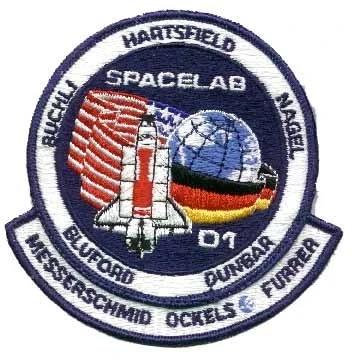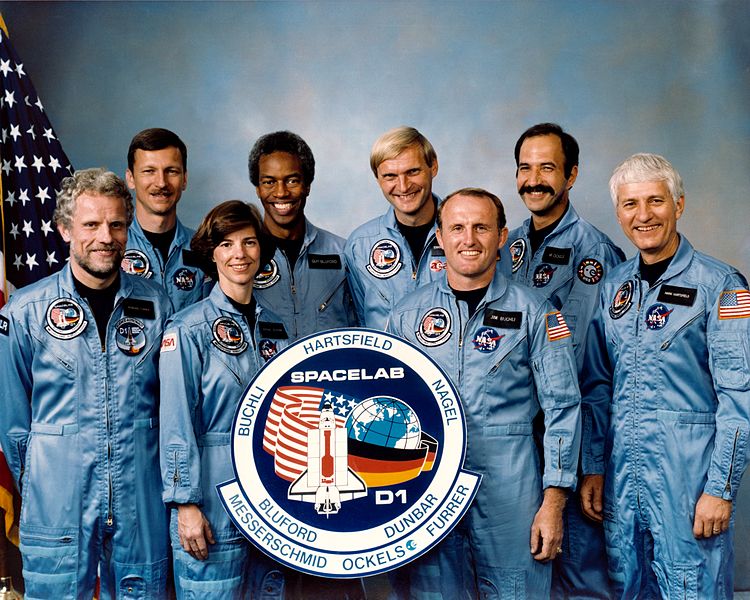Henry W. Hartsfield Jr.
(Third Space Flight)
Steven R. Nagel
(Second Space Flight)
Bonnie J. Dunbar
(First Space Flight) Mission Specialist 1:
James F. Buchli
(Second Space Flight) Mission Specialist 2:
Guion S. Bluford
(First Space Flight) Payload Specialist 1:
Reinhard Furrer, DLR
(Only Space Flight) Payload Specialist 2:
Ernst Messerschmid, DLR
(Only Space Flight) Payload Specialist 3:
Wubbo Ockels, ESA
STS-61-A (also known as D-1) was the 22nd mission of NASA's Space Shuttle Programme It was a scientific Spacelabmission, funded and directed by West Germany- hence the non-NASA designation of D-1 (for Deutschland-11). STS-61-A was the last successful mission of the Space Shuttle Challenger which was destroyed during STS-51-L in 1986. STS-61-A currently holds the record for the largest crew, eight people, aboard any single spacecraft for the entire period from launch to landing.
The mission carried the NASA/ESA Spacelab module into orbit with 76 scientific experiments on board, and was declared a success. Payload operations were controlled from the German Space Operations Center in Oberpfaffenhofen West Germany, instead of from the regular NASA control centres.
Backup Crew:
Payload Specialist 3: Ulf Merbold, ESA
A free template by Lucknowwebs.com for WYSIWYG WebBuilder 8
Study
Research
Main Index
Space Cosmology
Science Research
*
About
Science Research
Science Theories
Desk
Site Map
BookShelf
Copyright © by Nigel G Wilcox · All Rights reserved · E-Mail: ngwilcox100@gmail.com
Designed by Nigel G Wilcox
Powered By AM3L1A
Pages within this section: USA Shuttle Mission Flights
STS-61a
Pages within this section:
The Space Shuttle Missions
Astronauts:
STS-61a
Command Pilot:
Pilot:
60
M
8
SM
Sub-Menu
menu
-
61
61a
61b
61c
61e
61h
61m
(Second Space Flight) Mission Specialist 3:


The primary task of STS-61-A was to conduct a series of experiments, almost all related to functions in microgravity, in Spacelab D-1, the third flight of a Spacelab orbital laboratory module. Two other mission assignments were to deploy the Global Low Orbiting Message Relay Satellite (GLOMR) out of a Getaway Special canister in the cargo bay, and to operate five materials processing experiments, which were mounted in the orbiter's payload bay on a separate device called the German Unique Support Structure. The experiments included investigations into fluid physics, with experiments in capillarity, Marangoni convection, diffusion phenomena, and critical points; solidification experiments; single crystal growth; composites; biological studies, including cell functions, developmental processes, and the ability of plants to perceive gravity; medical experiments, including the gravitational perceptions of humans, and their adaptation processes in space; and speed-time interaction studies of people working in space.
One equipment item of unusual interest was the Vestibular Sled, an ESA contribution consisting of a seat for a test subject that could be moved backward and forward with precisely controlled accelerations and stops, along rails fixed to the floor of the Spacelab aisle. By taking detailed measurements on a human strapped into the seat, scientists gained data on the functional organization of the human vestibular and orientation systems, and the vestibular adaptation processes under microgravity. The acceleration experiments by the sled riders were combined with thermal stimulations of the inner ear and optokinetic stimulations of the eye.
NASA operated the Space Shuttle, and was responsible for overall safety and control functions throughout the flight. West Germany was responsible for the scientific research carried out during the seven-day mission. To fulfill this function, German scientific controllers on the ground worked closely with the personnel in orbit, operating out of the German Space Operations Center at Oberpfaffenhofen, near Munich, West Germany. The orbiting crew was divided into two teams, working in shifts to ensure laboratory work was performed 24 hours a day. Communications were optimal throughout the mission and the ground and orbital crews were able to interact regularly. The overall system of one control center controlling spacecraft operations and a second controlling experiment functions worked smoothly in practice.
Clearwater Lakes in Quebec, Canada (meteorite impact craters) as seen during the mission
The GLOMR satellite was successfully deployed during the mission, and the five experiments mounted on the separate structure behind the Spacelab module obtained useful data. Challenger landed, for what was to be the last time, on Runway 17 at Edwards Air Force Base on November 6, 1985. The wheels stopped rolling at 12:45 pm EST, after a mission duration of 7 days and 45 minutes.
STS-61-A marked the last successful mission of Space Shuttle Challenger, which would be destroyed with all hands on board during the launch of the STS-51-L mission on January 28, 1986.
Space Shuttle Challenger lifted off from Pad A of Launch Complex 39 at Kennedy Space Center, Florida, at 12:00 EST on October 30, 1985. This was the first Space Shuttle mission largely financed and operated by another nation, West Germany. It was also the only Shuttle flight to launch with a crew of eight. The crew members included Henry W. Hartsfield, Jr., commander; Steven R. Nagel, pilot; Bonnie J. Dunbar, James F. Buchli and Guion S. Bluford, mission specialists; and Ernst Messerschmid and Reinhard Furrer of West Germany, along with first Dutch astronaut Wubbo Ockels of the European Space Agency (ESA), all payload specialists.














